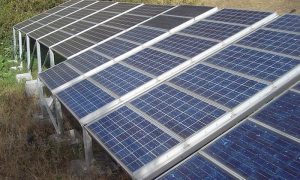By Jason Hopkins
California lawmakers are preparing to vote on a sweeping renewable energy bill, but critics question whether the legislation can feasibly be implemented.

Solar panels produce large amounts of energy throughout the day, but are unable to generate power at night when residents are more dependent on electricity to keep the lights on.
The California state legislature could vote on Senate Bill 100 as soon as Monday, according to Kevin de Leon, a Democratic state senator and sponsor of the bill. If passed and signed into law, SB 100 would dramatically reform California’s energy mix, mandating a 50 percent renewables target by 2026 and then a 60 percent target by 2030. By 2045, the bill calls for all of the state’s energy consumption originate from zero-carbon sources.
De Leon and other supporters claim the bill will save ratepayers money on electricity bills. However, several utilities are warning the opposite would happen, predicting the transition would create overhead costs that would be passed down to consumers.
“We believe Senate Bill 100 takes strides toward moving to a holistic statewide solution to reducing greenhouse gas emissions, but critical details need to be amended to protect customers from rate increases and to maintain reliability,” Pacific Gas & Electric Company said in a statement. “The statute should be amended to protect customers from high costs.”
 California consistency ranks as one of the most expensive areas in terms of residential electricity rates. The current renewable energy standard in the state is 50 percent by 2030.
California consistency ranks as one of the most expensive areas in terms of residential electricity rates. The current renewable energy standard in the state is 50 percent by 2030.
Beyond the concerns over rate increases, critics have openly questioned whether such a mandate is even possible. Robert Bryce, a senior fellow at the Manhattan Institute, explained how California doesn’t have enough land to sustain a 100-percent renewable energy mix.
“To expand renewables to the extent that they could approach the amount of energy needed to run [California’s] entire economy would require wrecking vast onshore and offshore territories with forests of wind turbines and sprawling solar projects,” Bryce wrote in a Los Angeles Times op-ed.
Under Bryce’s calculations, California would require: more solar capacity than currently exists in the entire world, onshore wind farms that take up about four times the land area of Los Angeles County and offshore wind development 70 times bigger than the 468-megawatt Cape Wind proposal that failed to gain traction.
Content created by The Daily Caller News Foundation is available without charge to any eligible news publisher that can provide a large audience. For licensing opportunities for this original content, email licensing@dailycallernewsfoundation.org.



If we worked together to improve our planet, be better stewards rather then being run by lobbyists and those intent on subverting the basic tenants that make our country great we’d go a long way to improving the world. As with many things lobbyists and those trying to proffer off government mandates they make up are again driving the bus. There is so much we can do, would do by working together, becoming good stewards.
That 100% RE by 2045 likely refers to electricity, which is only 40% of all primary energy.
To have 100% RE of All primary energy by 2045 is far more difficult.
Here is an example of New England “electrifying the transportation sector” with:
1) Expensive, variable, intermittent wind and solar, or with
2) Imported Russian and Middle East LNG at 3 times the price of domestic pipeline gas.
They make it sound as if we are transitioning from old fashioned gas light to electric lighting, which was great. Electrifying the transportation would be also great?
Replacing New England Gasoline Consumption with Electricity in the Future
The US population is about 327 million, consumes about 143 billion gallons of gas/y.
The NE population is about 15 million, consumes about 6.560 billion gallons of gasoline/y, by proration.
The total CO2 of a gallon of gasoline (E10) is about 23.816 lb, including upstream.
The CO2 emitted by the gasoline is about 70.862 million metric ton/y, at an assumed 25 mpg.
New Englanders drive about 163.99 billion miles/y.
Electricity required using EVs would be about 69.41 billion kWh/y, at an assumed 0.423 kWh/mile, fed to grid.
The assumed 0.350 kWh/mile, per EV meter, is the average of cars, minivans, SUVs, ¼-ton pick-ups and larger pick-ups.
Replacing 31.54 billion kWh of NE nuclear in 2017 with LNG requires 68 tanker loads of LNG/y. See above.
Replacing gasoline with electricity from LNG requires 69.41/31.54 x 68 = 150 tanker loads/y, for a total of 218 tanker loads/y. See table.
This analysis covers only gasoline. Diesel fuel, heat pumps, etc., would be in addition.
EVs Charging During Nighttime:
Another utopian dream of 100% RE proponents is EVs would be charged at night, and that it would “flatten the demand” curve. Either it is just glib talk to fool lay people, or they do not have a clue, or both.
If we assume all EVs would be charged from 10 pm to 6 am, every day, the increase in nighttime demand would be 69.41 billion kWh/y/(8 x 365)/1000 = 23772 MW.
– That would be a significant increase of the normal nighttime demand of about 12000 MW. The normal daytime peak demand is about 22000 MW.
– The existing gas turbine capacity (which by now would include the gas turbines needed to replace nuclear) likely could provide that new nighttime demand and electricity. See table.
– Future heat pumps would impose very significant additional daytime demand increases during hot days in summer and 24-h/d additional demand increases during cold days in winter.
– The winter demand increases of EVs plus heat pumps would severely stress NE generation capacity and NE grid.
NOTE: 100% RE proponents will say, NE will be building out wind and solar, but they always fail to tell us the total of unreliable, variable, expensive wind and solar can be minimal at any time of the year, and for many hours of the year. That means the following requirements:
1) A full complement of gas turbines to provide peaking, filling-in and balancing services and any electricity not provided by wind and solar, and/or
2) TWh-scale storage systems (delivered as AC to high voltage grids)
Wind and solar cannot ever be relied upon for electric service at 99.97% reliability, 24/7/365, year after year.
On an AC-to-AC basis, about 20% of any energy passing through storage is lost.
Additional generation is required to make up for that loss.
http://www.windtaskforce.org/profiles/blogs/new-england-governors-statement-on-regional-energy-affordabilit-1